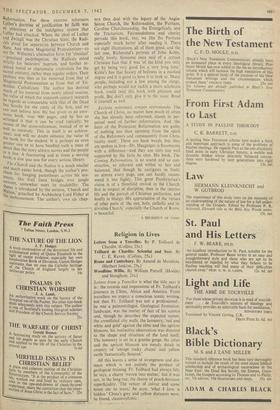Churches and the Church
The Church and the Nation: Six Studies in the Anglican Tradition. By Charles Smyth' (Hodder and Stoughton, 18s.) MOST of the histories of the European sixteenth century that have been written hitherto have presented the Reformation as a conflict simply between Protestant and Catholic. A distinguis"7.c ;
,
American scholar, Dr. George HUIltSt011 t hams, now shows convincingly that not two only but three main bodies of Christians were 1115," contending as to what constituted the true fait', and practice of the Church; two at any' rate °L. these were also deeply at variance within them" selves. Dr. Williams includes in his third body all the sundry sorts of Anabaptists. Spiritualists_ and spiritualisers also in variety, and the Eva ,ifid gelical Rationalists, mostly of Italian origin; af,-ts he calls the movement represented by these sects the Radical—as distinct from the Protestant Reformation. For these extreme reformers Luther's doctrine of justification by faith was as abhorrent as the indulgence system that Luther had attacked. Where the ideal of Luther and Zwingli was the Christian State, the Radi- cals stood for separation between Church and State. And where Magisterial Protestantism-4o use Dr. Williams's alternative form for 'classical —practised paidobaptism, the Radicals stood strictly for believers' baptism, and further re- quired moral or charismatic credentials for the sacred ministry, rather than regular orders. Their position was thus as far removed from that of Magisterial Protestantism as from that of Tri- dentine Catholicism. The author has derived much of his material from newly edited sources, the value of which for sixteenth-century research he regards as comparable with that of the Dead Sea Scrolls for the study of the first, and we can well believe him. He has given us an enor- mous book, over 900 pages, and he has so arranged it that it can be read topically, by means of the cross-references, instead of or as well as cursively. This in itself is an achieve- ment, and will no doubt enhance the value of the book for the student It is perhaps an even greater one so to have handled such a mass of detail that the story always moves and the 'people in It live. A fascinating and at times a moving book, a sine qua non for every serious library. The Church and the Nation is a much smaller and much easier book, though the author's pen- chant for hanging parentheses across his sen- tences, like frail liana bridges over jungle torrents, ents, somewhat mars its readability. The Ntheme nth ronement e is introduced by the sermon, 'Church and h.at'011,' preached by The Archbishoauthor's p own Lord six c Fisherhap at s e-
ters then deal with the legacy of the Anglo- Saxon Church, the Reformation, the Puritans, Caroline Churchmanship, the Evangelicals, and the Tractarians. Fairmindedness and charity pervade this book, too; we like the Puritans especially much better after reading it. There are eight illustrations, all of them good, and the last one, Richmond's portrait of John Keble, really lovely. Someone once said of a certain Christian face that it was 'of the kind you only get by being very good for a very long time.' Keble's has that beauty of holiness in a marked degree and it is good to have it to look at. Many people, including not a few among the clergy, who perhaps would not tackle a more scholastic book, could read this book with pleasure and profit. But don't only give it to the vicar. Read it yourself as well.
Ecclesia reformata sent per reformanda. The Church of Christ, no matter how much or often she has already been reformed, stands in per- petual need of further reformation. And 'the heirs of the Protestant Reformation are guilty of nothing less than apostasy from the spirit of the Reformers and consequently from Chris- tianity itself.' These are hard words, but they are spoken in love—Dr. Macgregor is Savonarola with a difference—and they are only too well supported by the facts he cites. His book, The Coming Reformation, is so sound and so con- structive, so relevant and withal so fair and balanced, that though he castigates us freely on almost every page, one can hardly recom- mend it too highly. This great Presbyterian's vision is of a threefold revival in the Church, first in respect of discipline, then in the interior life and the pursuit of Christian perfection, and finally in liturgy. His appreciation of the virtues of other parts of 'the one, holy, catholic and in- divisible Church,' especially the Church of Rome, - is beautiful.
A RELIGIOUS OF CSMV







































 Previous page
Previous page